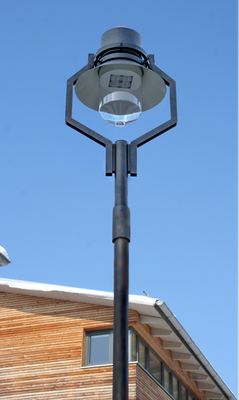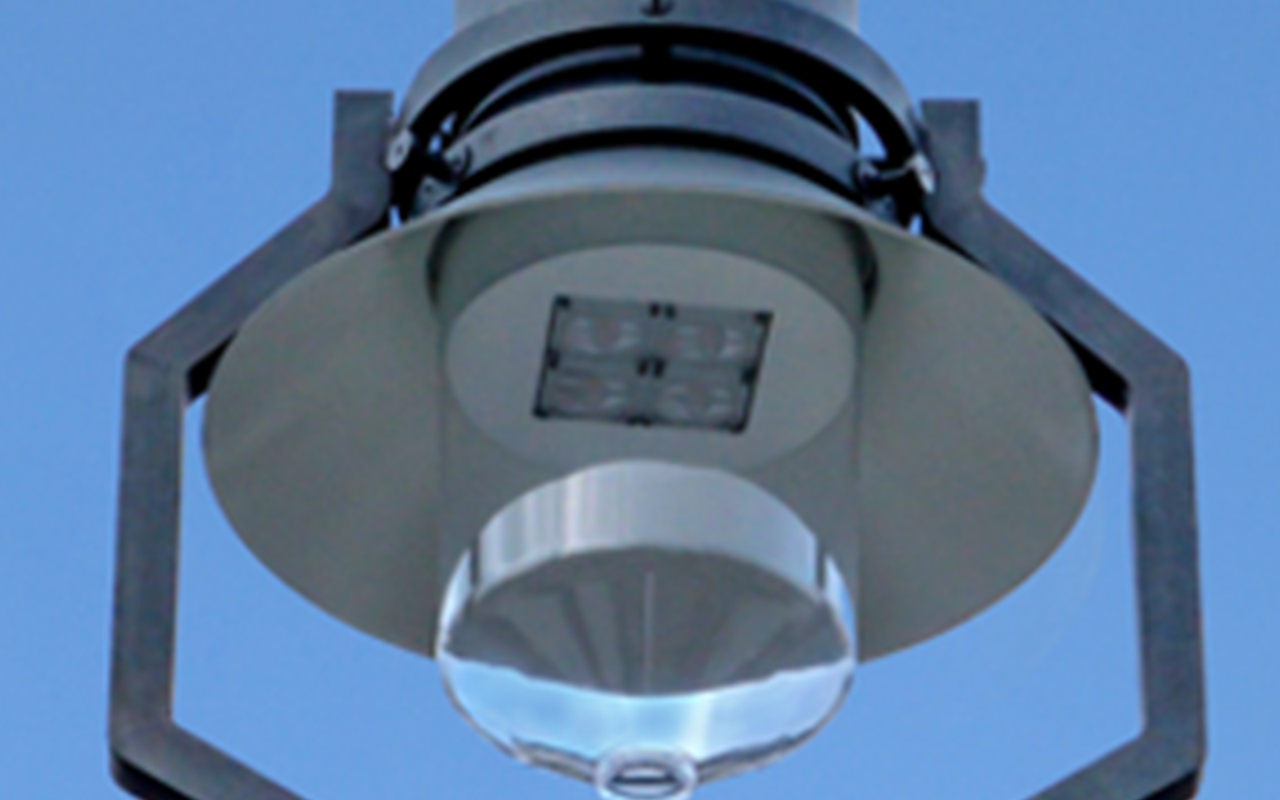NICHIA LED Technology Presented at LICHTWOCHE München
LED manufacturer NICHIA, a specialist in highly efficient lighting, Human Centric Lighting and the imitation of natural light, will participate in the Munich Lichtwoche 2021 from 5 to 12 November with a light installation, two presentations and a discussion on the topic of UV-C. The light installation in Pflaum Park, developed in cooperation with Munich-based LED specialist feno and luminaire manufacturer Bergmeister Leuchten, consists of two street luminaires of the popular "Rosenheim" type, one equipped with a classic high-pressure sodium lamp (HPS) and one with the latest generation of Nichia high-performance LEDs of the 219F family. Interested parties can thus experience both lighting technologies in direct comparison and experience the next evolutionary stage of inner-city lighting.
Joint project "Rosenheim" shines in Munich's Pflaum Park
HPS - a controversial classic
HPS are widely used in outdoor areas and especially in histroric center-cities and are very popular because of their monochrome, yellowish-warm light. The light attracts fewer mosquitoes and is less of a nuisance to nocturnal animals. Despite ever louder criticism because of the mercury required in HPS, which has already led to bans in various European countries, they are still often found in the cityscape in Germany - not least because of their high efficiency of up to 150 lm/W, which allows good visibility even in diffuse ambient conditions. Until now, LEDs with the usual white ANSI colour space of 2,700 to 6,500 Kelvin have not been able to achieve the desired spectrum of 1,800 to 2,500 Kelvin of HPS. Attempts with orange LEDs have always failed so far due to a lack of efficiency and colour rendering.
NICHIA's 219F - a globally unique alternative
With its high-power 219F LED family, Nichia has addressed precisely this challenge. The family covers the colour spectrum from 2,500 K to now, for the first time for an LED, 1,800 K. At the same time, it achieves an efficiency of around 120 - 140 lm/W. An advantage over HPS is the colour rendering index (CRI), which describes the colour rendering compared to sunlight. While most sodium vapour lamps have CRI values of less than 5, i. e. they render colours very poorly, the 219F 1800K has CRI values of over 70, which means that the LEDs can render colours much more clearly and naturally than HPS.
Joint solution "Rosenheim" - natural light for a sustainable city
At the Munich Lichtwoche 2021, those interested can now view both luminaires in direct comparison in Pflaum Park. LED innovator Nichia will be presenting the new 219F 1800K LEDs, while renowned manufacturer Bergmeister Leuchten will be exhibiting two mast luminaires of the widely used "Rosenheim" type - one with the conventional HPS and one with the new Nichia LEDs. Long-time Nichia partner feno, a Munich-based expert in LED lighting concepts and implementations, developed a prototype module for the LED variant consisting of a total of 16 219F 1800K LEDs in a total of four nests, perfectly matched to the structural and technical requirements of the Rosenheim luminaire.
Ulf Meiners, Managing Director of Nichia Europe GmbH is delighted with the joint project.
"The installation here at the Munich Lichtwoche gives us a wonderful opportunity to present the uniqueness of our new 219F 1800 K live and in colour. This new LED offers cities and municipalities a technically almost equivalent and, what's more, environmentally friendly, sustainable replacement for the previous HPS luminaires."
–Ulf Meiners, Managing Director of Nichia Europe GmbH
 Alexander Müller, Head of Sales and Marketing at feno GmbH adds: "At feno we combine lighting technology with lighting experiences. This fits perfectly with this joint project. We show that natural and pleasant light can be realised in a technically uncomplicated way. The sustainability goals of cities and communities can also be taken into account. We are very pleased that we were able to make a valuable contribution here again." Simon Hochreiter, Managing Director of Bergmeister Leuchten, is also enthusiastic about the joint project: "The "Rosenheim" is still a popular luminaire for inner-city lighting today. This project shows our classic luminaire with a new look and thus proves the future viability of our luminaires - not only for new purchases but also for the many existing luminaires. The public sector can thus act in a more sustainable, environmentally friendly and efficient way without having to change the carefully planned cityscape."
Alexander Müller, Head of Sales and Marketing at feno GmbH adds: "At feno we combine lighting technology with lighting experiences. This fits perfectly with this joint project. We show that natural and pleasant light can be realised in a technically uncomplicated way. The sustainability goals of cities and communities can also be taken into account. We are very pleased that we were able to make a valuable contribution here again." Simon Hochreiter, Managing Director of Bergmeister Leuchten, is also enthusiastic about the joint project: "The "Rosenheim" is still a popular luminaire for inner-city lighting today. This project shows our classic luminaire with a new look and thus proves the future viability of our luminaires - not only for new purchases but also for the many existing luminaires. The public sector can thus act in a more sustainable, environmentally friendly and efficient way without having to change the carefully planned cityscape."
Presentations of the project will take place on Tuesday, 9 November, and Wednesday, 10 November, both from 6 to 7 p.m. in Pflaum Park. As part of the Munich Lichtwoche, Nichia will also be giving a lecture on the subject of UV-C on Wednesday, 10 November, between 2 and 4 pm.
About NICHIA Corporation
Having ‘Ever Researching for a Brighter World’ as a motto, NICHIA takes great pride in being the technology leader and world’s largest LED manufacturer. Founded in 1956 as a specialist chemical producer, NICHIA quickly became the leader in luminescent materials (phosphors). Nichia later developed and commercialized the first high brightness blue LED in 1993 and the first white LED in 1996. Additional nitride-based LEDs in various colors were developed, including ultraviolet and visible laser diodes. NICHIA believes that its products will remain at the forefront of energy efficient solutions throughout the world for years to come.
NICHIA will continue to be a company that makes contributions to the world by evolving its original and unique technologies and ‘Ever Researching for a Brighter World’.
For more information, visit www.NICHIA.com
Image copyright Bergmeister Leuchten.
___
© 2021 LED professional / Luger Research e.U.

